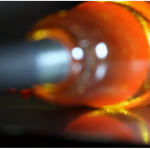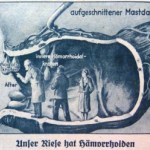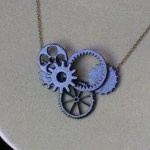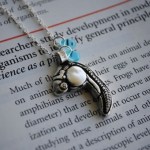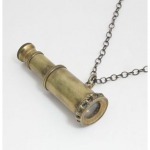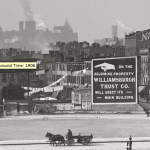Retrotechnology and steampunk
"we find ourselves constantly experimenting and pushing the boundaries. . . the really great thing about our business is the fact that we take raw materials, and we design, we color, we make. . . and we have complete control of the process. It's very gratifying."
Danny Cooke, maker of the short documentary about glass painting that I featured last October, has a new short film to distract you this Sunday. It's about a team of glassblowers, Mark Tranter, Patricia Tranter-Edmonds, and Lee James, who set up a small studio in a historic stableyard in Cockington Village, UK. The first three…
So I'm all in favor of promoting struggling artists, and that includes documentary filmmakers. But I have to say I'm a little taken aback by the aesthetic of the "Synthetic Bio" documentary project by Field Test Films (and endorsed by Carl Zimmer). They've posted a short over at Kickstarter, where they're trying to raise $30K to finish the film in time for Sundance. But as one of my biologist friends pointed out, the soundtrack they use for the sample short (on producing spider silk in goat's milk) is eerie, mad-scientist stuff, complete with a Exorcist-like choir at the end.
I'm posting the…
Observatory is hosting another great event tonight:
From Heumann Heilmittel, "Eine Reise durch den menschlichen Körper" (1941)
Body Voyaging: an illustrated lecture with Kristen Ann Ehrenberger
Date: TONIGHT, Monday, January 17th
Time: 8:00 PM
Admission: $5
Presented by Morbid Anatomy
We human beings have a seemingly insatiable desire to experience the bodies underneath our skins. While many scholars have treated the subject of looking into or through bodies via medical imaging, one perhaps understudied trope is that of "body voyaging." A few writers and artists have imagined what it…
Peter Eudenbach's mixed media artworks are inspired by technology gone right and gone wrong. Check out his coffee table that actually brews coffee, his Failed Attempt at Perpetual Motion, "based on a 16th century theory of perpetual motion that was never tested," or (euw) lead castings from the eye sockets of a human skull.
Well, this is certainly ephemera: a Norwegian musician made instruments out of ice and then played them. Sounds like a lot of very cold work to me.
PS: The msnbc clip I initially found suffers on embedding from A) a stupid preliminary ad, B) high volume on the stupid ad, and C) practically no volume at all on the, ahem, musical clip that is supposed to be the focus of attention. Pathetic, msnbc. I retaliated by replacing it with an itnnews clip from YouTube that has none of those problems. Click through to see the msnbc clip if you'd like more ice music.
This series of sciart wallpapers by Dan Funderburgh were inspired by the Time-Life Science Library, a series of educational books published in the 1960s. For those of us old enough to remember them, Time-Life's series are objects of nostalgia in themselves. Coupling the vintage design and palettes of those books with vintage sci-art symbolism yields a sharply contemporary set of prints.
Funderburgh describes his work as "a repudiation of the fabricated schism between art and decoration;" you could also describe it as a repudiation of the fabricated gulf between science and design. (Fun…
Fabrication de bonbons à Berlin from philmotion productions on Vimeo.
Via NOTCOT.
No. "If we could gather all the electric eels from all around the world," they would free their imprisoned brother from his Yuletide servitude and bio-tase the crap out of you, bro.
Just sayin'.
I have no idea how I missed this before the holidays (sorry!), but NBDesigns has a line of oxidized silver embryo jewelry that is pure vintage lab-chic. The embryonic mice are particularly adorable:
And, on the less-cute, more-sciency end of the spectrum, her embryonic chicks look just like illustrations in an old dev bio textbook:
I should also note, since we are coming up on Valentine's Day, that she makes Erlenmeyer flask earrings and pendants with little hearts. (You can also request a glass heart worked into the chain of the zebrafish embryo pendant, or check out her sloth & heart…
Via iO9, a Nature News slideshow of natural history engravings by physician Martin Lister's teenage daughters, who contributed technically accurate engravings of shells to one of his books, the Historiae Conchyliorum:
Historians now believe the pair were the first women to use microscopes to help produce some of their scientific drawings. Anna and Susanna's place in the history of science is explored in a biography of Martin Lister in preparation by historian Anna Marie Roos of the University of Oxford's Cultures of Knowledge project. In a recent web post, Roos describes how she stumbled…
The ultimate bioephemera: art you eat! This cephalopod by specialty cake artist Karen Portoleo is definitely NOT a cake wreck (although if there were a little cake(ship)wreck under those tentacles, it might not be a bad addition). Karen previously made a "gingerbread" house with an octopus icing and tiling the roof. For serious.
Thanks to Patricia for the link! (Check out Patricia's art blog, too).
National Museum of Health & Medicine has an amazing flickrstream of vintage medical photographs and other ephemera. Lately they've been adding diagnostic/documentary photos of Civil War soldiers, as well as some military propaganda posters (anti-VD and anti-food waste, of all things). This series of photos of a lab setup for measuring cranial capacity are my favorites. Check out the handled basket of skulls! And they're using an "insufflator!" I did not even know that was a word.
Happy holidays to our friends at Bottled Monsters and thanks for all the wonderful photos!
Whether you're studying, working, or just trying to stay warm this week, take a moment to appreciate this view of the inner workings of this positively Yeatsian music box:
Mechanical Bird Music Box
I admit it: I burst out laughing at the unexpected closure of the box. Poor little bird! (Yet he rose again, phoenix-like, to sing once more.)
From the collection of the Musical Instrument Museum. Thanks to my friend mdvlst for the link.
Want! (The telescope works!)
Digby and Iona Spyglass necklace, from Catbird.
In less than a month (December 2nd), Christie's will auction off Edward Tufte's library - an idiosyncratic collection of first edition books, plates, prints, and ephemera that the dataviz guru calls his "Museum of Cognitive Art," and I call "Jessica's Christmas List."
I'm not going to sample low-rez images of the lots here, because there's a stunning slideshow, complete with curation, at the Christie's website. If you've got ten minutes, this is virtual antiquarian dataviz windowshopping at its best.
There appear to be 160 lots; Tufte's website describes it as "200 rare books, including major…
With a poster titled "WE NEED YOUR BODY! For a UNIQUE OPPORTUNITY," microbiologist Steven Park and artist Anne Brodie invited attendees at the British Science Festival to
stand NAKED inside our live bioluminescent photograph booth and have your photograph taken. Enveloped by a living ethereal blue green light, the resulting faint and ghostly image will be used as part of an [art] installation. . .
The eerie results, which look a whole lot like TSA millimeter-wave scans, are appearing in an exhibition at the UK's Royal Institution through December 3. See a slideshow at the Londonist.
detail of "Williamsburg Bridge Plaza," Brooklyn, NY, circa 1906
Source: Shorpy
I'm just saying, I don't think that's a speck on the negative. But maybe I'm too cynical.
Reader Miles suggested Danny Cooke's graceful documentary about ornamental glass & sign artist David A. Smith, who uses traditional techniques like gilding, silvering, and etching to create ornate glass signs and windows with aesthetics from Victorian to Art Nouveau. Time-lapse sequences offer a surreal glimpse of Smith dexterously floating giant panels of glass around his studio, gently pressing them against grinders to carve the distinctive beveled patterns and fonts so familiar from vintage pubs or storefronts.
David A Smith - Sign Artist from Danny Cooke on Vimeo.
Particularly if…
This is what I miss out on by not reading the physical copy of the New York Times: ads! I recently picked up a copy of the Times science section and saw an ad for these wonderful vintage patent office models from the 1900s.
As if they're not steampunky enough, each one comes with a little yellowed, handwritten, calligraphic tag that I'm dying to read because I am convinced it must contain cryptic clues to some sort of awesome Neil Stephenson-style mystery. Right??
